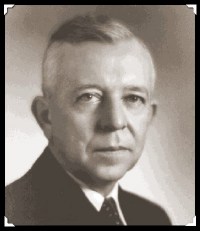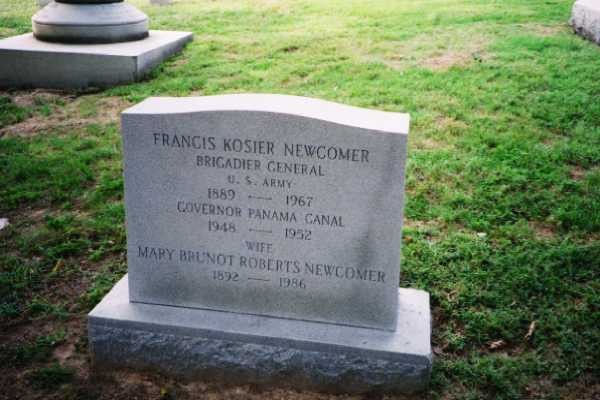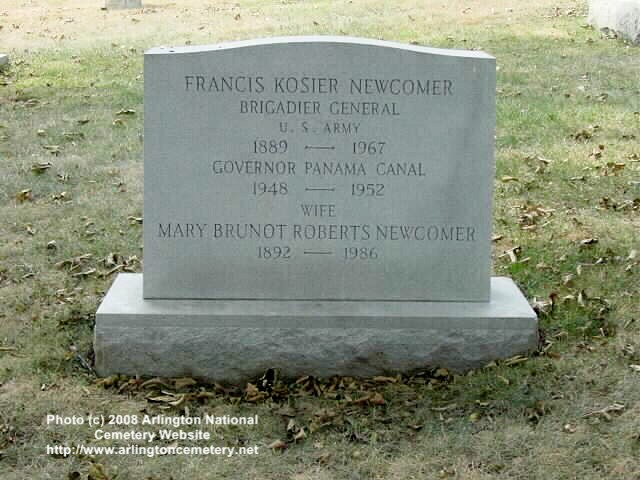Courtesy of the Panama Canal Commission:
The son of Henry Clay and Rebecca Newcomer, Francis Kosier Newcomer was born in Byron, Illinois, on September 14, 1889. In 1909 he received an appointment as a Cadet to the United States Military Academy at West Point. In June 1913 he received his bachelor’s degree upon graduation and was commissioned a Second Lieutenant in the U.S. Army Corps of Engineers. In 1914 he married Mary B. Roberts.
His initial Army appointment was to the First Engineer Battalion in Washington D.C. Barracks. From there he entered the United States Engineering School in that city, from which he graduated in 1916. That same year he was promoted to the rank of captain. He was assigned consecutively to the Second and Fourth Engineer Corps, located in Vancouver, Washington, and Camp Greene, North Carolina, respectively.
When the United States joined the Allies in World War I, Newcomer went to France to take part in the Aisne-Marne offensive and the Serre and Vesle defensives. From August 1918 to February 1919 he served as Assistant Commandant of the Army Engineer School at Langres, France, and later resumed duty with the Fourth Engineers. In the fall of 1919 he returned to the United States with the temporary rank of Lieutenant Colonel.
For the next five years, from 1919 to 1924, Newcomer was an associate professor of mathematics at the U.S. Military Academy at West Point. Then, in July 1924, he was appointed district engineer, Southeastern Division, Charleston, South Carolina, where he was in charge of fortifications and river and harbor works. In 1928 he was assigned to Fort Belvoir, Virginia, as an instructor in the Engineering School.
Having advanced to the rank of permanent lieutenant colonel, Newcomer, in 1939, entered the Army War College, Fort Humphreys, Washington, D.C., where officers received special training for wartime command and staff positions. He graduated in June 1940, and was appointed assistant to the president of the Mississippi River Commission and to the division engineer of the Lower Mississippi Valley Division at Vicksburg, Mississippi.
In May 1944, he became Panama Canal maintenance engineer, then part of the Caribbean Defense Command. That same year he received the rank of brigadier general. Newcomer served as chief assistant to then Panama Canal Governor, Major General Joseph Mehaffey. After serving for four years, Brigadier General Newcomer was appointed Governor of the Panama Canal Zone in May 1948 for the term of office ending in 1952.
During his tenure, questions of increasing the toll charges on privately owned vessels using the canal and of converting the lake canal to a sea-level route were under consideration. Also, for the first time in Canal history, the payment of tolls was initiated for ships operated or rented by the U.S. government. During his tenure the name of the Panama Canal changed to Panama Canal Company in 1951, and the terms of “Silver” and “Gold roll” to designate wage standard were abolished on November 21, 1948. In October 1949 Newcomer resigned from active Army duty but continued serving as governor of the Panama Canal until 1952. Newcomer died on August 16, 1967.
NOTE: His father, Henry Clay Newcomer and his mother, Rebecca Kosier Newcomer, are buried in an adjoining gravesite, as is his brother, David Albert Newcomer, Colonel, United States Army.
Michael Robert Patterson was born in Arlington and is the son of a former officer of the US Army. So it was no wonder that sooner or later his interests drew him to American history and especially to American military history. Many of his articles can be found on renowned portals like the New York Times, Washingtonpost or Wikipedia.
Reviewed by: Michael Howard



